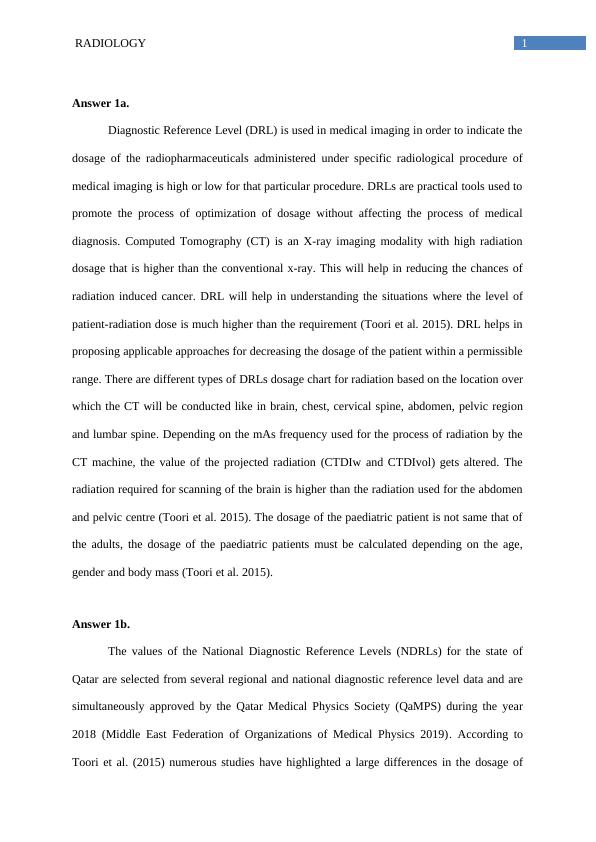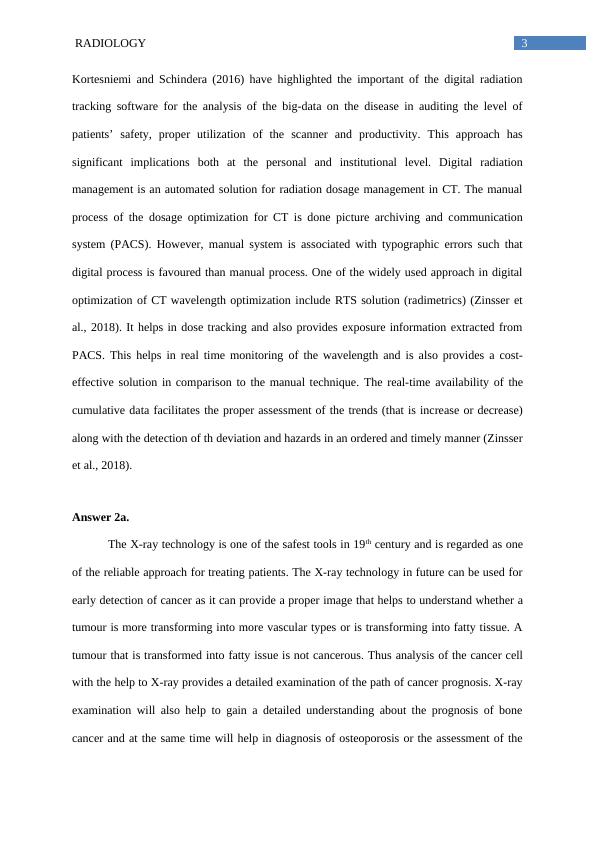Diagnostic Reference Level Answer 2022
12 Pages3652 Words19 Views
Added on 2022-09-17
Diagnostic Reference Level Answer 2022
Added on 2022-09-17
ShareRelated Documents
Running head: RADIOLOGY
Radiology
Name of the Student
Name of the University
Author Note
Radiology
Name of the Student
Name of the University
Author Note

1RADIOLOGY
Answer 1a.
Diagnostic Reference Level (DRL) is used in medical imaging in order to indicate the
dosage of the radiopharmaceuticals administered under specific radiological procedure of
medical imaging is high or low for that particular procedure. DRLs are practical tools used to
promote the process of optimization of dosage without affecting the process of medical
diagnosis. Computed Tomography (CT) is an X-ray imaging modality with high radiation
dosage that is higher than the conventional x-ray. This will help in reducing the chances of
radiation induced cancer. DRL will help in understanding the situations where the level of
patient-radiation dose is much higher than the requirement (Toori et al. 2015). DRL helps in
proposing applicable approaches for decreasing the dosage of the patient within a permissible
range. There are different types of DRLs dosage chart for radiation based on the location over
which the CT will be conducted like in brain, chest, cervical spine, abdomen, pelvic region
and lumbar spine. Depending on the mAs frequency used for the process of radiation by the
CT machine, the value of the projected radiation (CTDIw and CTDIvol) gets altered. The
radiation required for scanning of the brain is higher than the radiation used for the abdomen
and pelvic centre (Toori et al. 2015). The dosage of the paediatric patient is not same that of
the adults, the dosage of the paediatric patients must be calculated depending on the age,
gender and body mass (Toori et al. 2015).
Answer 1b.
The values of the National Diagnostic Reference Levels (NDRLs) for the state of
Qatar are selected from several regional and national diagnostic reference level data and are
simultaneously approved by the Qatar Medical Physics Society (QaMPS) during the year
2018 (Middle East Federation of Organizations of Medical Physics 2019). According to
Toori et al. (2015) numerous studies have highlighted a large differences in the dosage of
Answer 1a.
Diagnostic Reference Level (DRL) is used in medical imaging in order to indicate the
dosage of the radiopharmaceuticals administered under specific radiological procedure of
medical imaging is high or low for that particular procedure. DRLs are practical tools used to
promote the process of optimization of dosage without affecting the process of medical
diagnosis. Computed Tomography (CT) is an X-ray imaging modality with high radiation
dosage that is higher than the conventional x-ray. This will help in reducing the chances of
radiation induced cancer. DRL will help in understanding the situations where the level of
patient-radiation dose is much higher than the requirement (Toori et al. 2015). DRL helps in
proposing applicable approaches for decreasing the dosage of the patient within a permissible
range. There are different types of DRLs dosage chart for radiation based on the location over
which the CT will be conducted like in brain, chest, cervical spine, abdomen, pelvic region
and lumbar spine. Depending on the mAs frequency used for the process of radiation by the
CT machine, the value of the projected radiation (CTDIw and CTDIvol) gets altered. The
radiation required for scanning of the brain is higher than the radiation used for the abdomen
and pelvic centre (Toori et al. 2015). The dosage of the paediatric patient is not same that of
the adults, the dosage of the paediatric patients must be calculated depending on the age,
gender and body mass (Toori et al. 2015).
Answer 1b.
The values of the National Diagnostic Reference Levels (NDRLs) for the state of
Qatar are selected from several regional and national diagnostic reference level data and are
simultaneously approved by the Qatar Medical Physics Society (QaMPS) during the year
2018 (Middle East Federation of Organizations of Medical Physics 2019). According to
Toori et al. (2015) numerous studies have highlighted a large differences in the dosage of

2RADIOLOGY
radiation for the same CT examination under different hospital settings and these variations
occurs due to difference in the examination procedure and the scanner model of CT that is
used for the assessment. Thus establishment of the reference levels of the activity is helpful in
reducing the chances of the getting over-exposure from the ionising wavelength of radiation.
In order to establish the standard wavelength of radiation for the each of the local health-care
organization in Qatar the process of optimization must start by taking the reference level of
NDRLs. The data and levels of NDRLs must be considered by the employees while setting
their local, hospital based DRLs for conducting the CT (Middle East Federation of
Organizations of Medical Physics, 2019). In order to set the local diagnostic level of the
radiation wavelength for conduction of the CT, patient-related data based on the CT protocol
for the four most prescribed CT examinations must be collected. The four most exercised CT
examination in Qatar and its regional areas include brain, chest, sinus, pelvic and abdomen.
In each centre, the CT Dose Index (CDI) measurements must be performed by the use of the
pencil ionization chamber and CT dosimetry phantom as per the National Diagnostic
Reference Levels (NDRLs). Depending on this level of radiation, the standardization of the
CT system along with optimization of the CT radiation must be done. Optimizing the
wavelength of radiation for CT will help to reduce the chances of development of cancer
from excessive exposure to ionizing radiation (Toori et al. 2015).
Answer 1c.
Increasing concerns for radiation exposure arising from the CT have lead to several
advances in the dose reduction technologies. While required justifications and proper
optimization of scans has been the principal focus for addressing the increase in the dosage
levels, the value of the effective management of the radiation exposure or in other words
dosage management has been significantly over-looked (Zinsser et al., 2018). Parakh,
radiation for the same CT examination under different hospital settings and these variations
occurs due to difference in the examination procedure and the scanner model of CT that is
used for the assessment. Thus establishment of the reference levels of the activity is helpful in
reducing the chances of the getting over-exposure from the ionising wavelength of radiation.
In order to establish the standard wavelength of radiation for the each of the local health-care
organization in Qatar the process of optimization must start by taking the reference level of
NDRLs. The data and levels of NDRLs must be considered by the employees while setting
their local, hospital based DRLs for conducting the CT (Middle East Federation of
Organizations of Medical Physics, 2019). In order to set the local diagnostic level of the
radiation wavelength for conduction of the CT, patient-related data based on the CT protocol
for the four most prescribed CT examinations must be collected. The four most exercised CT
examination in Qatar and its regional areas include brain, chest, sinus, pelvic and abdomen.
In each centre, the CT Dose Index (CDI) measurements must be performed by the use of the
pencil ionization chamber and CT dosimetry phantom as per the National Diagnostic
Reference Levels (NDRLs). Depending on this level of radiation, the standardization of the
CT system along with optimization of the CT radiation must be done. Optimizing the
wavelength of radiation for CT will help to reduce the chances of development of cancer
from excessive exposure to ionizing radiation (Toori et al. 2015).
Answer 1c.
Increasing concerns for radiation exposure arising from the CT have lead to several
advances in the dose reduction technologies. While required justifications and proper
optimization of scans has been the principal focus for addressing the increase in the dosage
levels, the value of the effective management of the radiation exposure or in other words
dosage management has been significantly over-looked (Zinsser et al., 2018). Parakh,

3RADIOLOGY
Kortesniemi and Schindera (2016) have highlighted the important of the digital radiation
tracking software for the analysis of the big-data on the disease in auditing the level of
patients’ safety, proper utilization of the scanner and productivity. This approach has
significant implications both at the personal and institutional level. Digital radiation
management is an automated solution for radiation dosage management in CT. The manual
process of the dosage optimization for CT is done picture archiving and communication
system (PACS). However, manual system is associated with typographic errors such that
digital process is favoured than manual process. One of the widely used approach in digital
optimization of CT wavelength optimization include RTS solution (radimetrics) (Zinsser et
al., 2018). It helps in dose tracking and also provides exposure information extracted from
PACS. This helps in real time monitoring of the wavelength and is also provides a cost-
effective solution in comparison to the manual technique. The real-time availability of the
cumulative data facilitates the proper assessment of the trends (that is increase or decrease)
along with the detection of th deviation and hazards in an ordered and timely manner (Zinsser
et al., 2018).
Answer 2a.
The X-ray technology is one of the safest tools in 19th century and is regarded as one
of the reliable approach for treating patients. The X-ray technology in future can be used for
early detection of cancer as it can provide a proper image that helps to understand whether a
tumour is more transforming into more vascular types or is transforming into fatty tissue. A
tumour that is transformed into fatty issue is not cancerous. Thus analysis of the cancer cell
with the help to X-ray provides a detailed examination of the path of cancer prognosis. X-ray
examination will also help to gain a detailed understanding about the prognosis of bone
cancer and at the same time will help in diagnosis of osteoporosis or the assessment of the
Kortesniemi and Schindera (2016) have highlighted the important of the digital radiation
tracking software for the analysis of the big-data on the disease in auditing the level of
patients’ safety, proper utilization of the scanner and productivity. This approach has
significant implications both at the personal and institutional level. Digital radiation
management is an automated solution for radiation dosage management in CT. The manual
process of the dosage optimization for CT is done picture archiving and communication
system (PACS). However, manual system is associated with typographic errors such that
digital process is favoured than manual process. One of the widely used approach in digital
optimization of CT wavelength optimization include RTS solution (radimetrics) (Zinsser et
al., 2018). It helps in dose tracking and also provides exposure information extracted from
PACS. This helps in real time monitoring of the wavelength and is also provides a cost-
effective solution in comparison to the manual technique. The real-time availability of the
cumulative data facilitates the proper assessment of the trends (that is increase or decrease)
along with the detection of th deviation and hazards in an ordered and timely manner (Zinsser
et al., 2018).
Answer 2a.
The X-ray technology is one of the safest tools in 19th century and is regarded as one
of the reliable approach for treating patients. The X-ray technology in future can be used for
early detection of cancer as it can provide a proper image that helps to understand whether a
tumour is more transforming into more vascular types or is transforming into fatty tissue. A
tumour that is transformed into fatty issue is not cancerous. Thus analysis of the cancer cell
with the help to X-ray provides a detailed examination of the path of cancer prognosis. X-ray
examination will also help to gain a detailed understanding about the prognosis of bone
cancer and at the same time will help in diagnosis of osteoporosis or the assessment of the

End of preview
Want to access all the pages? Upload your documents or become a member.
Related Documents
Report on Imaging Modalitieslg...
|7
|1251
|286
Diagnostic Imaging Techniques in Paediatric Cancerlg...
|11
|3061
|438
Surveillance and Alert Systems in the Radiography Department in Qatarlg...
|7
|419
|16
Essay on Pharmacology and Therapeutics Caselg...
|13
|3790
|276
